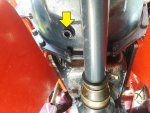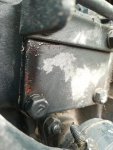Hello All,
I am a new member but have been reading top tips and information from the forum for about a year and I thank you all for you help so far! I farm a small holding in the UK, and have a B7001D to help me with the heavier work - which is mainly cutting grass.
I have a conundrum which I'm hoping somebody can help with....
I recently overheated my B7001D (I had not noticed the radiator getting clogged with seed heads etc) and the lower radiator pipe split, I shut the engine down straight away. After a quick in-field repair I got the tractor back and parked up and replaced the rad pipes. I later noticed there was a pinkish liquid leaking, it was dripping from around the bottom of the front axle, but it wasn't coming from there. It isn't engine oil (that is pretty dark and dipstick shows okay) it doesn't appear to be hydraulic oil, again, dipstick shows tank is full, it isn't radiator fluid, wrong colour.
I did wonder if it was a diesel leak, the colour is similar. So I cleaned up the entire engine applied some talc powder around a few parts of the engine to try and trace the leak. No clear leak from the fuel system, or anywhere around the engine bay really...
Then I found what looks like a drain point under where I think the clutch is. There is no plug in it, but it is a threaded hole.
I'm not sure how the leak would get from here to where it was dripping on the axle, but stranger things have happened.
I have uploaded a picture, I took it from under the tractor looking forward, you can see the drive shaft for the front wheels. Can anybody tell me if it is a drain point, and if it is, where do I fill this area from, and what grade oil?! I cannot find it in the manual (I'm using a B7100 manual).
Thanks in advance, I really appreciate it! The thistles have sensed the disaster and are growing faster by the day...!
I am a new member but have been reading top tips and information from the forum for about a year and I thank you all for you help so far! I farm a small holding in the UK, and have a B7001D to help me with the heavier work - which is mainly cutting grass.
I have a conundrum which I'm hoping somebody can help with....
I recently overheated my B7001D (I had not noticed the radiator getting clogged with seed heads etc) and the lower radiator pipe split, I shut the engine down straight away. After a quick in-field repair I got the tractor back and parked up and replaced the rad pipes. I later noticed there was a pinkish liquid leaking, it was dripping from around the bottom of the front axle, but it wasn't coming from there. It isn't engine oil (that is pretty dark and dipstick shows okay) it doesn't appear to be hydraulic oil, again, dipstick shows tank is full, it isn't radiator fluid, wrong colour.
I did wonder if it was a diesel leak, the colour is similar. So I cleaned up the entire engine applied some talc powder around a few parts of the engine to try and trace the leak. No clear leak from the fuel system, or anywhere around the engine bay really...
Then I found what looks like a drain point under where I think the clutch is. There is no plug in it, but it is a threaded hole.
I'm not sure how the leak would get from here to where it was dripping on the axle, but stranger things have happened.
I have uploaded a picture, I took it from under the tractor looking forward, you can see the drive shaft for the front wheels. Can anybody tell me if it is a drain point, and if it is, where do I fill this area from, and what grade oil?! I cannot find it in the manual (I'm using a B7100 manual).
Thanks in advance, I really appreciate it! The thistles have sensed the disaster and are growing faster by the day...!
Attachments
-
92.6 KB Views: 250




